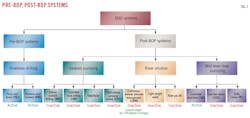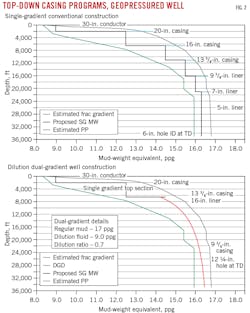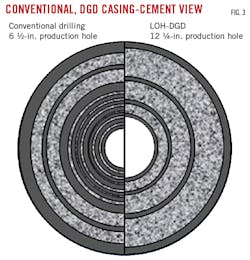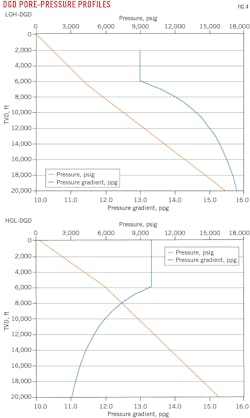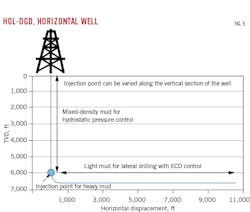Dilution-based dual gradient drilling reaches deep targets
Eric van Oort
Ultradeep Energy Co.
Austin, Tex.
Lewis Dutel
Lucas de Boer
Ultradeep Energy Co.
Houston, Tex.
Dilution-based dual-gradient drilling (DGD) reduces casing strings and drilling costs while increasing hole size at total depth by injecting mud down an artificially-created annulus with a different density than drilling mud pumped down the drillstring. The resulting distribution of fluid densities better matches difficult pore-pressure fracture gradient environments, more present in geopressured wells and wells with weak-loss zones overlying or underlying higher-pressured zones than in single-gradient mud profiles.
DGD enables economical exploration and development of deep hydrocarbon targets. It is also applicable to extended-reach development (ERD), horizontal, carbon sequestration, and geothermal wells. The latter may require DGD technology to drill and obtain a large hole size at depth for completion and economical heat production.
Dilution-based DGD
In the late 1990’s, it was realized that wells drilled in certain difficult pore-pressure fracture gradient (PPFG) environments, particularly in deepwater geologic settings, would be more efficiently drilled with a dual-gradient (DG) mud-pressure profile than a single-gradient profile. DG drilling reduces casing strings and accelerates well construction, reducing well costs and footprint. This activity spawned DGD innovations like both pre-BOP riserless drilling and post-BOP seabed pumping, mid-level riser pumping, and riser dilution (Fig. 1).
Despite the promise of DGD, there are currently only three systems that have survived and are practiced in the field: pre-BOP pump-and-dump (PAD) and riserless mud recovery (RMR), and post-BOP controlled mud level (CML). Reasons for this limited adoption include techno-economical concerns and difficulties affecting individual systems, impacts of the 2010 Macondo-Deepwater Horizon disaster, and industry downturns that have negatively affected deepwater well-construction activity.
The motivation to adopt DGD for negotiating certain PPFG environments is still compelling. Ultradeep Energy Co., therefore, has developed a dilution-based DGD technique for a larger set of applications than the continuous annular pressure management (CAPM) system on which it is based. CAPM was never put into field practice, but large-scale field tests provided proof-of-concept.
The principle and some of the benefits of dilution-based DGD are illustrated in Figs. 2-4. An injection fluid is pumped down an injection annulus with a density different from drilling mud pumped down the drillstring. This injection fluid mixes with the mud at the injection point to form return mud of mixed density. The presence of two fluid densities in the annulus—i.e., regular density mud below the injection point and mixed density mud above it—gives rise to a characteristic DGD curved-mud gradient shape. When the mixed-density mud arrives at surface, proprietary surface separation equipment separates it into regular density mud and injection fluid, which resume their circulation through the drillstring and injection annulus, respectively.
This surface separation is essentially shifting barite on a large scale to generate two fluids of unequal density. There are two DGD scenarios: light-over-heavy DGD (LOH-DGD), in which the injection fluid is lighter than the regular drilling mud, or heavy-over-light (HOL- DGD) with reverse mud-weight profiles.
LOH-DGD is like the most common MPD scenario and has the characteristic curved density profile shown in Fig. 2. In this geopressurized well (drilling with 17.0 ppg mud diluted by 9.0 ppg dilution fluid at a 0.7 dilution ratio) LOH-DGD better fits the pore-pressure fracture-gradient profile than a conventional single-gradient profile. This approach reduces required casing strings (three strings in this example) and leads to the following advantages:
- Reduction in the casing-cementing program and its complexity.
- Elimination of flat time for casing and cementing work, reducing well construction timelines by 50% and generating estimated cost savings of 30-50%.
- Increased drift diameter, which results in larger hole diameters for more versatile completion options in deep and ultradeep wells (Fig. 3). This is particularly important for geothermal wells which require larger production holes than oil and gas wells.1 2 Moreover, deeper geothermal wells (> 5 km) benefit from larger diameter drillpipe and drill collars to deliver the weight-on-bit and torque-on-bit needed to drill hard rock while controlling drillstring vibrations which limit ROP and bit life.
- Larger annuli that are more easily cementable and reduce risk of formation fluid and gas leakage to surface through compromised cement barriers (Fig. 3).
- Smaller carbon footprint stemming from a reduction of materials (casing, mud, cement, fuel) and well construction time.
Deep-target applications
LOH-DGD enables exploration and development of deep hydrocarbon targets such as the deep Tertiary gas play underlying large parts of the Gulf of Mexico coastal states and continental shelf. Attempts to develop this play, with wells such as Freeport-McMoran Oil & Gas’s Davy Jones, have proven economically unfeasible with conventional drilling, but LOH-DGD offers an alternative.3 Geothermal wells drilled in hot dry rock (HDR) may also provide opportunities for adoption, given the need to drill through long sedimentary stratigraphy to deep geothermal targets or control loss zones while simultaneously elevating mud pressure deeper in the well (preventing borehole closure from formation instability or visco-plastic creep).
HOL-DGD is suitable for drilling horizontal and extended reach drilling (ERD) wells which require light, low-solids fluids with reduced ECD (Fig. 4, bottom; Fig. 5). This scenario enhances ROP by providing cleaner, lower-solids fluids and reducing reduced formation impairment in permeable zones. It may also be suitable to deal with PPFG environments with natural or artificially-induced pressure regressions, such as formation depletion in mature plays.
The HOL-DGD pressure profile resembles that of surface back-pressure MPD (SBP-MPD), but with important differences. Contrary to SBP-MPD, the well is not pressurized at surface in HOL-DGD and there are no pipe-light conditions requiring special attention and consideration. The HOL-DGD pressure profile resembles that of SBP-MPD after circulating rollover mud in place and reducing back-pressure to zero while tripping out of hole. The HOL-DGD profile is identical to the SBP-MPD profile with rollover mud in the hole outside of one important caveat: no additional time has to be spent in HOL-DGD to achieve the desired annular-pressure profile. The system is always in place, while with SBP-MPD time, effort, and careful coordination is necessary to circulate heavy rollover mud in the hole and stage back-pressure down to zero while gaining hydrostatic head. This will greatly accelerate tripping times compared with SBP-MPD and avoid any mishaps that might occur if the rollover circulation procedure is performed incorrectly, including possible well-control issues if the staging down of back-pressure is not properly managed.
Both LOH-DGD and HOL-DGD techniques include detailed well-control procedures developed for their safe operation. In certain cases a combination of dilution-based DGD technology with SBP-MPD is recommended to provide both maximum flexibility in annular pressure manipulation and the benefits of SBP-MPD’s primary well-control capabilities.
HOL-DGD has the lowest barrier-to-entry of available technologies to test and further develop the large inventory of horizontal and ERD oil and gas wells that remains to be drilled. Opportunities include onshore oil and gas wells and geothermal wells.
References
- Fallah, A., Gu, Q., Chen, D., Ashok, P., van Oort, E., and Holmes, M., “Globally scalable geothermal energy production through managed pressure operation control of deep closed-loop well systems,” Energy Conversion and Management, Article 114056, Vol. 236, May 15, 2021.
- van Oort, E., Chen, D., Ashok, P., and Fallah, A., “Constructing Deep Closed-Loop Geothermal Wells for Globally Scalable Energy Production by Leveraging Oil and Gas ERD and HPHT Well Construction Expertise,” SPE-204097-MS, SPE/IADC International Drilling Conference and Exhibition, virtual, Mar. 8-12, 2021.
- van Oort, E., Dutel, L.J., and de Boer, L., “Dilution-based dual-gradient technique aims to remove limiters for drilling ultra-deep wells,” Drilling Contractor, Vol. 79, No. 1, Jan.-Feb. 2023.
The Authors
Eric van Oort ([email protected]) is J.J. King Chair of engineering at the University of Texas at Austin, and chief science officer (CSO) of Ultradeep Energy Co. He holds a PhD (1990) in physical chemistry from the University of Amsterdam. He is a member of the Society of Petroleum Engineers (SPE).
Lewis J. Dutel is the chief executive officer (CEO) of UltraDeep Energy Co. He holds a BS (1996) in Mechanical Engineering from the University of Louisiana at Lafayette.
Lucas deBoer is the chief technology officer (CTO) of UltraDeep Energy Company. He graduated from the Maritime Academy Amsterdam (1969) and holds a chief engineer license.
